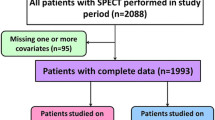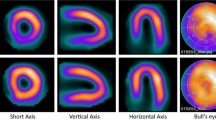Abstract
Background
The photon sensitivity and spatial resolution of single-photon emission-computed tomography (SPECT) has been significantly improved by solid-state camera systems using cadmium zinc telluride (CZT) detectors. While the diagnostic accuracy of these systems is well established, there is little evidence directly comparing the prognostic utility to conventional NaI cameras.
Methods and Results
Retrospective analysis of patients undergoing SPECT between 2008 and 2012. Visual SPECT assessment was performed utilizing the 17-segment model to determine summed stress scores (SSS). We identified 12,830 consecutive patients, mean age 63.2 ± 13.7 and 56.1% male, 5072 of whom underwent CZT and 7758 NaI imaging. During a median follow-up duration of 7.0 years (IQR 5.5-8.2), a total of 2788 (21.7%) patients died. Compared to SSS 0, minimal perfusion abnormality (SSS 1-3) was associated with increased all-cause mortality with CZT camera (adjusted HR 1.32, P = .017) and NaI camera (adjusted HR 1.29, P = .001, interaction P = .803). Increasing stress abnormality was associated with a similar increase in risk with CZT or NaI imaging (interaction P > .500). In a propensity matched analysis, patients with normal perfusion stress perfusion assessed with a CZT was associated with decreased mortality compared to normal perfusion assessed by a NaI camera system (hazard ratio .88, 95% CI .78-.99, P = .040).
Conclusions
Increasing stress perfusion abnormality was associated with similar increase in all-cause mortality with CZT or NaI cameras. CZT and NaI camera systems provide similar risk stratification, however, normal myocardial perfusion may be associated with a more benign prognosis when assessed with a CZT camera system.



Similar content being viewed by others
Abbreviations
- BMI:
-
Body mass index
- CABG:
-
Coronary artery bypass grafting
- CAD:
-
Coronary artery disease
- CZT:
-
Cadmium zinc telluride
- HR:
-
Hazard ratio
- IQR:
-
Interquartile range
- LV:
-
Left ventricle
- LVEF:
-
Left ventricular ejection fraction
- MPI:
-
Myocardial perfusion imaging
- NaI:
-
Sodium iodide
- PCI:
-
Percutaneous coronary intervention
- SD:
-
Standard deviation
- SRS:
-
Summed rest score
- SSS:
-
Summed stress score
- SPECT:
-
Single-photon emission computed tomography
- TID:
-
Transient ischemic dilation
References
Fihn SD, Blankenship JC, Alexander KP, Bittl JA, Byrne JG, Fletcher BJ et al. J Am Coll Cardiol 2014;64:1929-49.
Berman DS, Kang X, Hayes SW, Friedman JD, Cohen I, Abidov A et al. Adenosine myocardial perfusion single-photon emission computed tomography in women compared with men: Impact of diabetes mellitus on incremental prognostic value and effect on patient management. J Am Coll Cardiol 2003;41:1125-33.
Hachamovitch R, Rozanski A, Hayes SW, Thomson LE, Germano G, Friedman JD et al. Predicting therapeutic benefit from myocardial revascularization procedures: Are measurements of both resting left ventricular ejection fraction and stress-induced myocardial ischemia necessary? J Nucl Cardiol 2006;13:768-78.
Romero-Farina G, Candell-Riera J, Aguadé-Bruix S, Ferreira-González I, Cuberas-Borrós G, Pizzi N et al. Warranty periods for normal myocardial perfusion stress SPECT. J Nucl Cardiol 2015;22:44-54.
Slomka PJ, Patton JA, Berman DS, Germano G. Advances in technical aspects of myocardial perfusion SPECT imaging. J Nucl Cardiol 2009;16:255-76.
Garcia EV, Faber TL, Esteves FP. Cardiac dedicated ultrafast SPECT cameras: New designs and clinical implications. J Nucl Med 2011;52:210-17.
Slomka P, Miller RJ, Hu L-H, Germano G, Berman D. Solid-state detector SPECT myocardial perfusion imaging. J Nucl Med 2019;60 (9):1194-204.
Bocher M, Blevis IM, Tsukerman L, Shrem Y, Kovalski G, Volokh L. A fast cardiac gamma camera with dynamic SPECT capabilities: Design, system validation and future potential. Eur J Nucl Med Mol Imaging 2010;37:1887-902.
Gimelli A, Bottai M, Giorgetti A, Genovesi D, Kusch A, Ripoli A et al. Circ Cardiovasc Imaging 2011;4:51-8.
Duvall WL, Croft LB, Ginsberg ES, Einstein AJ, Guma KA, George T et al. Reduced isotope dose and imaging time with a high-efficiency CZT SPECT camera. J Nucl Cardiol 2011;18:847-57.
Sharir T, Ben-Haim S, Merzon K, Prochorov V, Dickman D, Ben-Haim S et al. High-speed myocardial perfusion imaging: Initial clinical comparison with conventional dual detector anger camera imaging. JACC Cardiovasc Imaging 2008;1:156-63.
Nkoulou R, Pazhenkottil AP, Kuest SM, Ghadri JR, Wolfrum M, Husmann L et al. Semiconductor detectors allow low-dose-low-dose 1-day SPECT myocardial perfusion imaging. J Nucl Med 2011;52:1204-9.
Nudi F, Iskandrian AE, Schillaci O, Peruzzi M, Frati G, Biondi-Zoccai G. Diagnostic accuracy of myocardial perfusion imaging with CZT technology. Systemic review and meta-analysis of comparison with invasive coronary angiography. JACC Cardiovasc Imaging 2017;10:787-94.
Berman DS, Kiat H, Friedman JD, Wang FP, van Train K, Matzer L et al. Separate acquisition rest thallium-201/stress technetium-99m sestamibi dual-isotope myocardial perfusion single-photon emission computed tomography: A clinical validation study. J Am Coll Cardiol 1993;22:1455-64.
Berman DS, Abidov A, Kang X, Hayes SW, Friedman JD, Sciammarella MG et al. Prognostic validation of a 17-segment score derived from a 20-segment score for myocardial perfusion spect interpretation. J Nucl Cardiol 2004;11:414-23.
Cerqueira MD, Weissman NJ, Dilsizian V, Jacobs AK, Kaul S, Laskey WK et al. Standardized myocardial segmentation and nomenclature for tomographic imaging of the heart. A statement for healthcare professionals from the Cardiac Imaging Committee of the council on clinical cardiology of the American Heart Association. Circulation 2002;105:539-42.
Hachamovitch R, Hayes SW, Friedman JD, Cohen I, Berman DS. Comparison of the short-term survival benefit associated with revascularization compared with medical therapy in patients with no prior coronary artery disease undergoing stress myocardial perfusion single photon emission computed tomography. Circulation 2003;107:2900-7.
Miller RJH, Hu LH, Gransar H, Betancur J, Eisenberg E, Otaki Y et al. Transient ischaemic dilation and post-stress wall motion abnormality increase risk in patients with less than moderate ischaemia: Analysis of the REFINE SPECT registry. Eur Heart J Cardiovasc Imaging 2019;21:567-75.
Otaki Y, Betancur J, Sharir T, Hu LH, Gransar H, Liang JX et al. 5-Year prognostic value of quantitative versus visual MPI in subtle perfusion defects: Results from REFINE SPECT. JACC Cardiovasc Imaging 2019;13:774-85.
Slomka PJ, Berman DS, Germano G. Normal limits for transient ischemic dilation with 99mTc myocardial perfusion SPECT protocols. J Nucl Cardiol 2017;24:1709-11.
Joergensen T, Hansson SH. Evaluation of the left ventricular ejection fraction with gated IQ-SPECT myocardial perfusion imaging. J Nucl Med Tech 2015;43:193-200.
Nakazato R, Berman DS, Gransar H, Hyun M, Miranda-Peats R, Kite FC et al. Prognostic value of quantitative high-speed myocardial perfusion imaging. J Nucl Cardiol 2012;19:1113-23.
Engbers EM, Timmer JR, Mouden M, Knollema S, Jager PL, Ottervanger JP. Prognostic value of myocardial perfusion imaging with a cadmium-zinc-telluride SPECT camera in patients suspected of having coronary artery disease. J Nucl Med 2017;58:1459-63.
Yokota S, Mouden M, Ottervanger JP, Engbers E, Knollema S, Timmer JR et al. Prognostic value of normal stress-only myocardial perfusion imaging: A comparison between conventional and CZT-based SPECT. Eur J Nucl Med Mol Imaging 2016;43:296-301.
Elze MC, Gregson J, Baber U, Williamson E, Sartori S, Mehran R et al. Comparison of propensity score methods and covariate adjustment: Evaluation in 4 cardiovascular studies. J Am Coll Cardiol 2017;69:345-57.
Lima R, Peclat T, Soares T, Ferreira C, Souza AC, Camargo G. Comparison of the prognostic value of myocardial perfusion imaging using a CZT-SPECT camera with a conventional anger camera. J Nucl Cardiol 2017;24:245-51.
Abidov A, Hachamovitch R, Hayes SW, Friedman JD, Cohen I, Kang X et al. Are shades of gray prognostically useful in reporting myocardial perfusion single-photon emission computed tomography? Circ Cardiovasc Imaging 2009;2:290-98.
Usher-Smith JA, Sharp SJ, Griffin SJ. The spectrum effect in tests for risk prediction, screening, and diagnosis. BMJ 2016;353:3139.
Lauer MS, Blackstone EH, Young JB, Topol EJ. Cause of death in clinical research: Time for a reassessment? J Am Coll Cardiol 1999;34:618-20.
Author information
Authors and Affiliations
Corresponding author
Ethics declarations
Disclosures
Drs. Berman, and Slomka participate in software royalties for QPS/QGS software at Cedars-Sinai Medical Center.
Additional information
Publisher's Note
Springer Nature remains neutral with regard to jurisdictional claims in published maps and institutional affiliations.
The authors of this article have provided a PowerPoint file, available for download at SpringerLink, which summarises the contents of the paper and is free for re-use at meetings and presentations. Search for the article DOI on SpringerLink.com.
The authors have also provided an audio summary of the article, which is available to download as ESM, or to listen to via the JNC/ASNC Podcast.
Funding
The work was supported in part by the Dr. Miriam and Sheldon G. Adelson Medical Research Foundation.
Electronic supplementary material
Below is the link to the electronic supplementary material.
Rights and permissions
About this article
Cite this article
Miller, R.J.H., Han, D., Rozanski, A. et al. CZT camera systems may provide better risk stratification for low-risk patients. J. Nucl. Cardiol. 28, 2927–2936 (2021). https://doi.org/10.1007/s12350-020-02128-x
Received:
Accepted:
Published:
Issue Date:
DOI: https://doi.org/10.1007/s12350-020-02128-x




